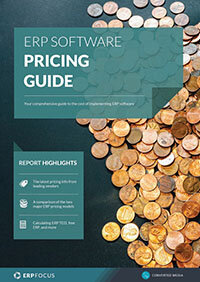Benefits of ERP for reducing purchasing costs
There are many reasons for implementing a new ERP system and, although cost reduction is only one of them, even if not explicitly targeted it is at least expected. This is the first of a series of blogs that investigate opportunities for reductions in purchasing costs, inventory holding costs, manufacturing costs, and admin costs. The final blog will approach things from a slightly different angle and look at increasing profitability.
Reducing purchasing costs is always a very worthwhile objective but many companies don’t stop to consider just how worthwhile it actually is. The fact is that every penny saved on purchasing goes straight to the organization's bottom line, so any effort expended in getting the most out of a purchasing system is well worth the effort. ERP can help reduce costs through demand forecasting, by achieving better discounts and by demand consolidation.
Demand forecasting
Demand forecasting can significantly reduce purchasing costs because it allows discounts to be negotiated upfront and, even more importantly, it also allows purchasing staff to identify those items where efforts to obtain or improve discounts will pay the biggest dividends. It is sufficiently important to have been addressed already, as a topic in its own right, in a blog on this website, so will not be considered in-depth here. Suffice to say that this previous blog offers practical advice to companies that don't believe that they can forecast.
Discounts
There are actually two categories of supplier discounts that ERP can help with: quantity and value discounts that are offered at the point of order, and retrospective discounts that are usually based on total spend over a period of time; normally a year.
Quantity and value discounts are more likely to be obtained when MRP (Materials Requirements Planning) consolidates individual order requirements into one order line; for example, most ERP systems give the option of ordering enough stock to satisfy demand for the next 7, 14, 30 days or whatever, rather than a fixed quantity. But companies have to make a judgement, item by item, on the period of time over which demand should be consolidated. It is probably acceptable to order, say, a month’s supply of cheap consumables but even one week’s supply of expensive (or bulky) items might be excessive and, to complicate matters, some items may have limited shelf lives.
Another consideration is that there may be minimum order quantities or values that attract discounts with, say, a supplier offering discounts on complete case sizes or pallet loads. If predicted use justifies it, it can make sense to enter those quantities as minimum order quantities, and order quantity increments, to the MRP system so that it orders a minimum of one pallet load and then multiples of pallet load beyond that. One thing to consider is that, especially for consumables, MRP systems generally recognise EOQ (Economic order quantities) and, indeed, some even calculate these. But EOQ doesn’t recognise discounts and it might not make sense to order an EOQ of 900 when the supplier only offers discounts on quantities of 1,000 or more.
Incidentally, if using EOQ, a useful exercise is to generate a report from the ERP system to compare EOQ with average or projected usage and then to calculate how long that amount of stock is likely to last. Then, having done so, multiply the EOQ by the unit price and display details of any item where the stock is likely to last for more than, say, one month and where the value of that stock is considered significant. Finally, consider whether use of EOQ is appropriate for this item. If EOQ turns out to be several weeks (or months) usage, it might make sense to ignore it.
When negotiating discounts with suppliers, there can be the temptation to pursue every opportunity but this may not be a good use of available time. There is little value in negotiating a 25% discount on a low value and low usage item; whereas even a small discount can be significant on a high value or high usage item. And, again, ERP can help. All will have an ABC analysis report available and most will allow it to be run against several criteria. Finance may want to run it against stock value to identify which items are contributing most to that measurement, the warehouse may want to run it against usage quantity to identify the items that should be stored in the most convenient locations, Sales may want to run it against sales value to identify their best sellers, but Purchasing should run it against purchase values to identify the items that they spend most on. And these are the items that should be targeted for discount.
Demand consolidation
As discussed earlier, one advantage of using MRP is that demand for items can be consolidated. This not only can result in companies obtaining discounts that they would otherwise have missed but offers an extra bonus in that it reduces purchasing, receiving and inspection effort, and therefore costs. But, for some companies, there can be even more benefits.
ERP, when running across a group of companies, facilitates group level purchasing. When several locations (whether distribution warehouses or factories) share the same system, they can usually use the same database, where records and data are effectively partitioned so that, for example, managers may be able to access data at all locations but individual inventory controllers or sales staff many only be able to access or transact data that is relevant to their own location (you probably don’t want the Berlin warehouse to raise requisitions for delivery to the Madrid warehouse). However; it might make sense for requisitions from both Berlin and Madrid to be visible to the Amsterdam central purchasing department.
Obviously, it makes sense for all locations to use the same part/product/SKU number but most capable ERP systems will allow them to use their own item descriptions, in their own language. So; the Berlin warehouse wants some handles and requisitions 100 ABC123 griffe; Madrid requisitions 100 ABC123 manijas, Amsterdam central purchasing sees a consolidated demand for 200 ABC123 handgrepen and sends an order for 200 maniglie to their Italian supplier, (good ERP systems, in fact, allow the supplier part number to be transposed onto the purchase order, so the Italian supplier probably gets a purchase order that asks for 200 XYZ789 maniglie and not a part number that is unrecognizable to them) along with instructions to deliver 100 separately to each location.
Of course, not all discounts are offered at an order, or order line, level. Companies frequently get a retrospective discount (or rebate) based upon business over a period of time; most frequently the past year. Both the purchasing and accounts payable modules will have reports available to show the value of purchases over a period of time from any particular supplier; information that can be used for both future and retrospective discounts equally.
It is clear that ERP systems have a mine of information that can be used to reduce purchasing costs. Hopefully, this and the following blogs will trigger ideas that will generate significant benefits.
Free white paper

ERP Software Pricing Guide
Get the latest pricing information on over 80 popular ERP systems, and learn how to budget for your ERP project in our free guide

Related articles
-

ERP Document Management: Production, Purchasing & Paper
Learn about the role ERP document management can play in improving business processes such as pro...
-

CMMC Compliance: What Aerospace and Defense Manufacturers Need to Know
Key insights on CMMC compliance, deadlines, and securing DoD contracts with CMMC 2.0 certificatio...

